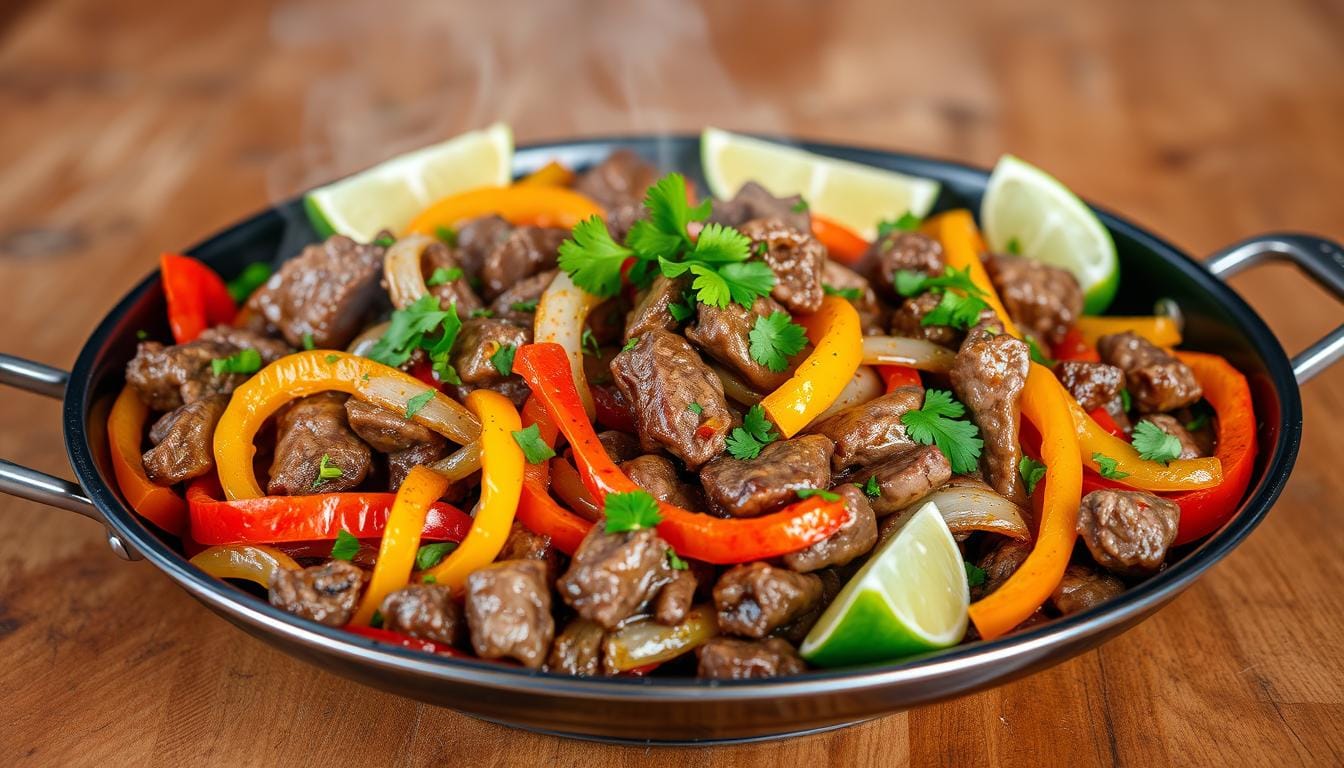Beef Fajitas: A Mouthwatering Mexican Meal
My first taste of beef fajitas in a Texas restaurant changed me. The flavors were so vibrant and the sizzle so enticing. It was more than food; it was an experience that made every meal special.
Beef fajitas are more than a meal; they’re a celebration of Mexican culture. They feature tender beef, colorful peppers, and onions, all in warm tortillas. They’re perfect for family dinners and gatherings, loved by many in the U.S.
In this guide, we’ll show you how to make amazing beef fajitas at home. You’ll learn about the best meat cuts and how to season them. We’ll help you create a delicious Mexican-American dish that will wow your loved ones.
Table of Contents
The Rich History of Fajitas in Mexican Cuisine
Beef fajitas take us on a journey through Mexican and Tex-Mex cooking. They started as simple meals for ranch workers. Now, they are a favorite in Mexican-American food.
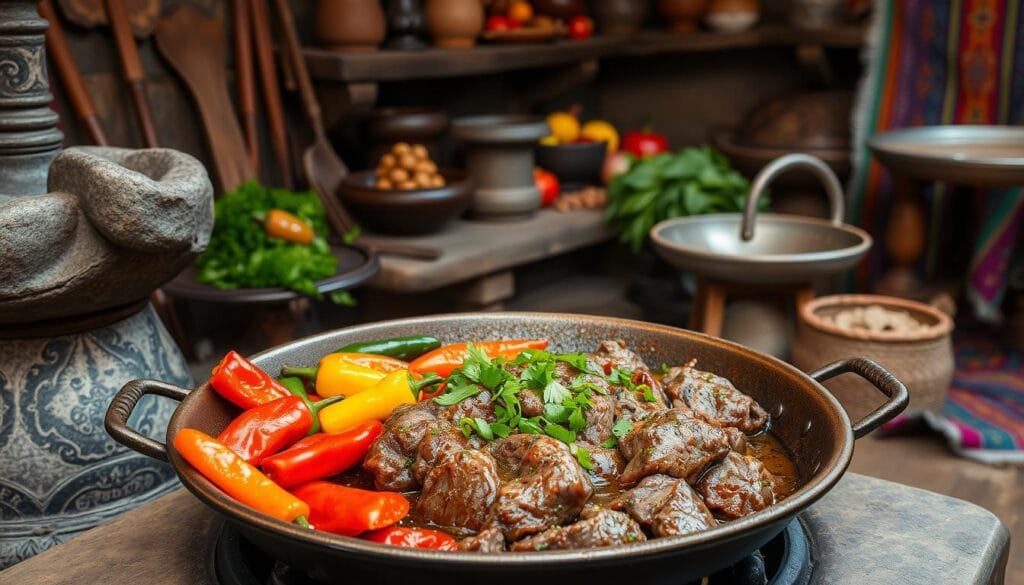
Origins in Texas Border Towns
In the 1930s, Texas border towns saw the birth of beef fajitas. Vaqueros, or ranch workers, used tough cuts of beef. Skirt steak, once thrown away, became the key ingredient in this Tex-Mex classic.
- Ranch workers first prepared fajitas using tough meat cuts
- Cooking methods included grilling over open flames
- Seasoning techniques developed from local culinary traditions
Evolution from Ranch Food to Restaurant Favorite
By the 1960s, fajitas moved from ranches to restaurants. The Rio Grande Valley’s eateries showcased these tasty dishes. They introduced fajitas to more people.
“Fajitas are more than just a meal; they’re a celebration of culinary innovation and cultural heritage.” – Mexican Culinary Historian
Cultural Significance in Mexican-American Cuisine
Now, beef fajitas show the mix of Mexican and American cooking. They celebrate the creativity and flexibility of Tex-Mex food. They bring people together with their amazing flavors and shared meals.
Essential Ingredients for Perfect Beef Fajitas
To make delicious beef fajitas, you need the right mix of ingredients. The quality of your steak fajitas depends on the ingredients you pick. Let’s explore the key elements that make this dish amazing.
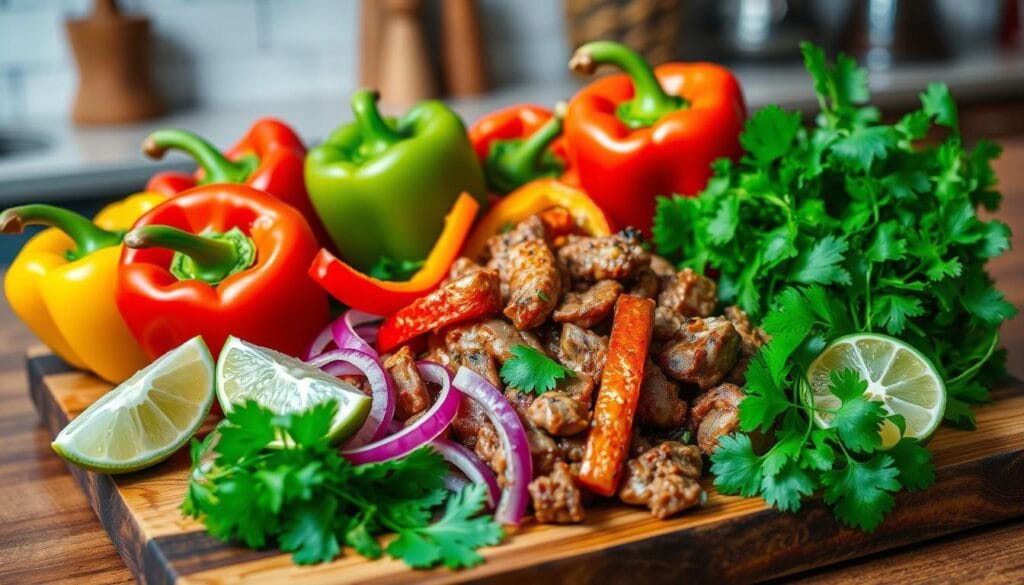
For authentic beef fajitas, you’ll need a few key ingredients. These turn a simple meal into a memorable experience:
- Protein Selection: Skirt steak or flank steak are the traditional cuts for beef fajitas, known for their rich flavor and tender texture
- Fresh Vegetables: Bell peppers and onions are essential for authentic fajita preparation
- Fajita Seasoning: A blend of spices that adds depth and authenticity to your dish
The secret to great fajitas is your fajita seasoning. A perfect blend includes:
- Chili powder
- Cumin
- Smoked paprika
- Garlic powder
- Salt and black pepper
“Great fajitas are about balance – each ingredient should complement the others without overpowering the dish.” – Chef Maria Rodriguez
Your beef fajitas will stand out with quality ingredients and proper preparation. Fresh veggies, top-notch meat, and a strong fajita seasoning are key. They make a meal that takes you straight to the heart of Mexican cuisine.
Selecting the Best Cut of Beef for Your Fajitas
Choosing the right cut of meat is key to great beef fajitas. The perfect steak brings flavor and tenderness to your dish.
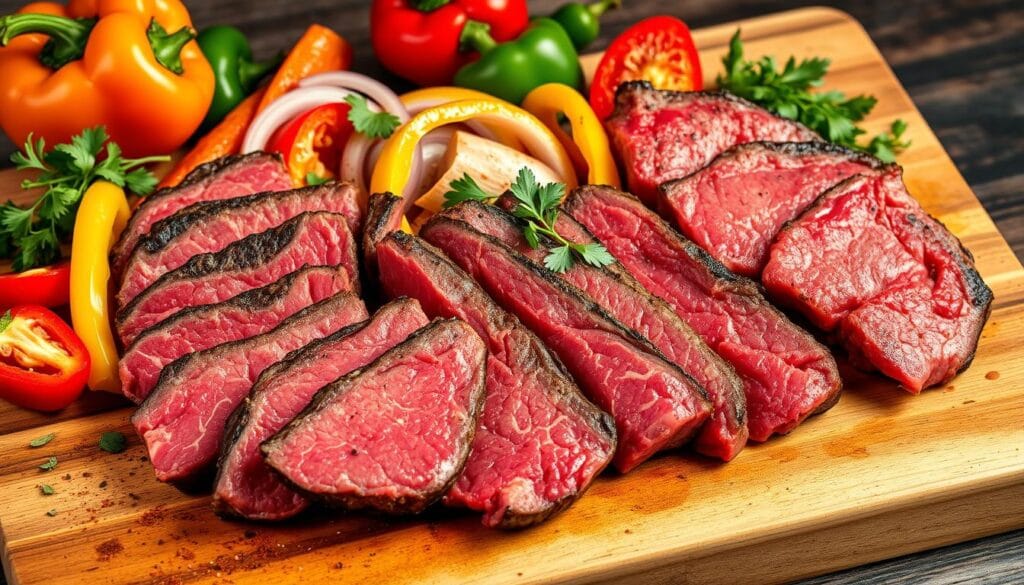
When making steak fajitas, picking the right meat is important. Not all cuts are the same. Knowing the differences can make your dish better.
Skirt Steak vs Flank Steak
Two cuts are favorites for beef fajitas:
- Skirt Steak: It has a strong beefy taste and great texture.
- Flank Steak: It’s leaner but grills well.
Meat Grade and Quality Considerations
| Meat Grade | Flavor Profile | Recommended for Fajitas |
|---|---|---|
| USDA Prime | Rich, marbled, exceptional taste | Highest quality, most expensive |
| USDA Choice | Good marbling, balanced flavor | Best overall value |
| USDA Select | Leaner, less intense flavor | Budget-friendly option |
Proper Meat Thickness and Preparation
For the best beef fajitas, look for steaks that are:
- Consistently cut (about 1/2 inch thick)
- Trimmed of excess fat
- Sliced against the grain
“The secret to great fajitas is not just the cut, but how you prepare and grill the meat.” – Chef Maria Rodriguez
Grilled meat benefits from choosing the right cut and proper preparation. Whether you pick skirt or flank steak, focus on quality and technique for unforgettable fajitas.
Authentic Fajita Seasoning and Marinade Recipes
Making perfect beef fajitas begins with mastering fajita seasoning. Mexican cooking is all about the right mix of spices. Your homemade seasoning can take your dish from good to great.
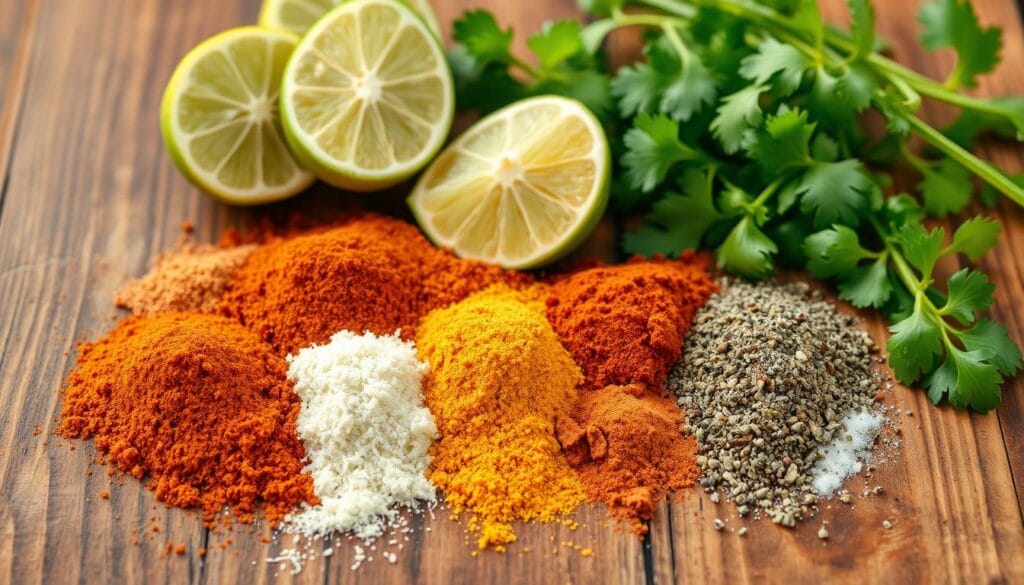
Authentic fajita seasoning is about the right spice mix. Here are the must-haves for traditional Mexican fajita seasoning:
- Chili powder
- Cumin
- Paprika
- Garlic powder
- Dried oregano
- Salt and black pepper
“The soul of Mexican cuisine is in its spices” – Traditional Mexican Chef
For amazing beef fajitas, try this marinade recipe. It adds deep flavors:
| Ingredient | Quantity | Purpose |
|---|---|---|
| Lime juice | 1/4 cup | Tenderizes meat |
| Olive oil | 2 tablespoons | Adds moisture |
| Fajita seasoning | 2 tablespoons | Provides flavor |
| Soy sauce | 1 tablespoon | Enhances umami |
Mix these ingredients well and marinate your beef for at least 2 hours. Longer marinating means more flavor. Remember, the secret to great fajitas is in the spice balance and letting the meat’s taste shine.
Step-by-Step Guide to Grilling Beef Fajitas
Grilling the perfect beef fajitas needs skill and precision. The secret to great steak fajitas is mastering heat, timing, and prep. Whether you’re a grill pro or a weekend cook, these tips will make your meat impress everyone.
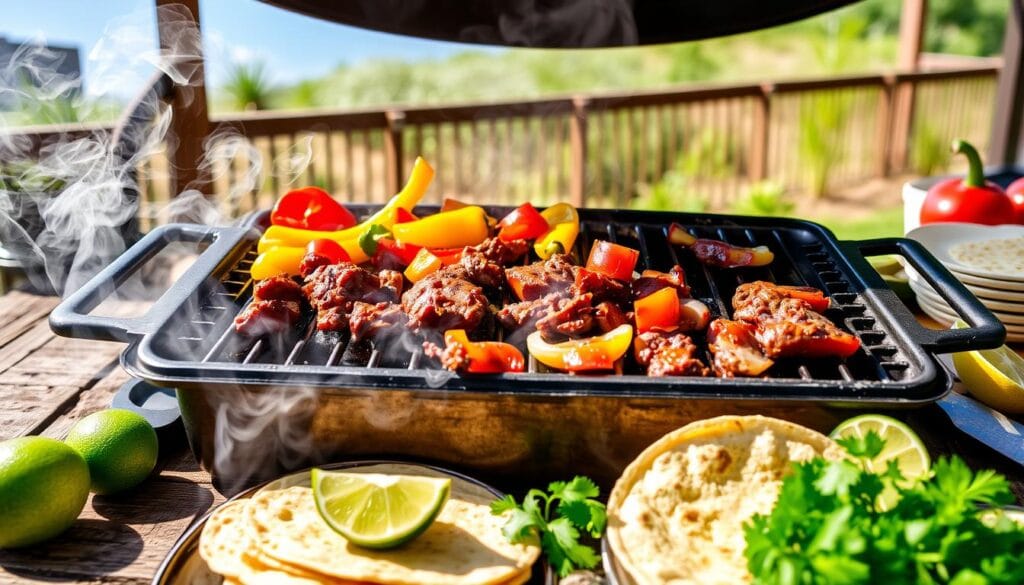
Proper Grilling Temperature
Getting the right temperature is key for beef fajitas. Heat your grill to 450-500°F. This high heat gives char marks and keeps the steak juicy. Use a meat thermometer for accurate results.
- Preheat grill for 10-15 minutes
- Clean and oil grates before cooking
- Use direct high heat for beef fajitas
Timing and Meat Doneness
Cooking time varies with meat thickness and desired doneness. Grill skirt steak or flank steak for 4-5 minutes per side for medium-rare. Pro tip: Thinner cuts cook faster and stay more tender.
| Doneness | Internal Temperature | Cooking Time |
|---|---|---|
| Rare | 125°F | 3-4 minutes per side |
| Medium-Rare | 135°F | 4-5 minutes per side |
| Medium | 145°F | 5-6 minutes per side |
Resting and Slicing Techniques
After grilling, let your beef fajitas rest for 5-10 minutes. This step makes each bite tender and flavorful. Slice the meat against the grain at a 45-degree angle for tenderness.
“The difference between good and great fajitas is in the resting and slicing technique.” – Professional Chef
- Let meat rest on a cutting board
- Use a sharp knife for clean cuts
- Slice perpendicular to meat fibers
Mastering the Art of Tortilla Selection and Preparation
Tortilla wraps are key to authentic Mexican cuisine, like in beef fajitas. The right tortilla can make your fajita experience unforgettable.
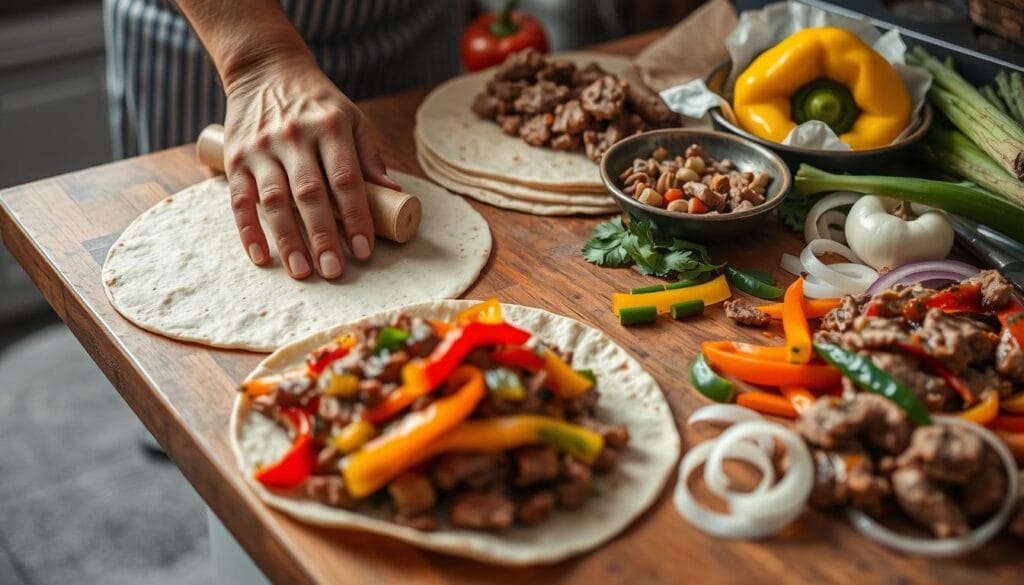
When picking tortillas for your beef fajitas, think about a few things:
- Corn tortillas: Traditional and gluten-free option
- Flour tortillas: Softer and more flexible
- Whole wheat tortillas: Healthier alternative
Pro tip: Always choose fresh, high-quality tortillas for the best flavor and texture.
“The perfect tortilla is the foundation of an amazing fajita experience.” – Mexican Culinary Expert
Heating techniques are important for your tortillas. Here are some ways to do it right:
- Skillet method: Quick 30-second warm-up on each side
- Oven method: Wrap in foil and heat at 350°F for 10 minutes
- Direct flame: 5-10 seconds per side for a charred flavor
To keep tortillas warm and pliable, use a tortilla warmer or wrap them in a clean kitchen towel. This keeps your beef fajitas hot and tasty from start to finish.
Fresh Vegetables and Toppings for Traditional Fajitas
Making perfect beef fajitas is more than just cooking the meat. The right mix of veggies and toppings makes a big difference. Choose fresh, vibrant ingredients to make your fajitas truly special.
Classic Pepper and Onion Combinations
Bell peppers and onions are key to traditional beef fajitas. The best mix includes:
- Red bell peppers for sweetness
- Green bell peppers for a bit of bitterness
- Yellow bell peppers for color
- Sweet white or red onions, sliced thin
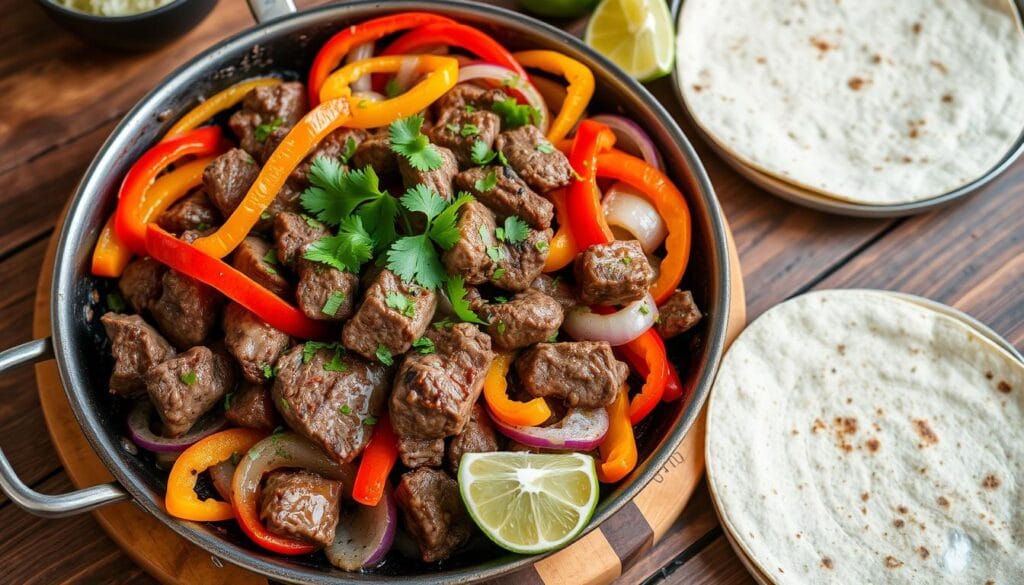
Expanding Your Vegetable Palette
While bell peppers and onions are classic, you can add more veggies for nutrition and taste:
- Grilled zucchini strips
- Roasted poblano peppers
- Charred jalapeños for extra heat
- Sautéed mushrooms
Garnish and Condiment Selections
Your beef fajitas need amazing toppings. Here are some favorites:
| Garnish | Flavor Profile |
|---|---|
| Fresh guacamole | Creamy, rich |
| Pico de gallo | Bright, fresh |
| Sour cream | Cool, tangy |
| Chopped cilantro | Herbaceous, vibrant |
“The secret to great beef fajitas is balancing flavors and textures with fresh, quality ingredients.” – Chef Maria Rodriguez
Pro tip: Always slice your bell peppers and onions against the grain for the most tender and flavorful beef fajitas experience.
Essential Side Dishes to Complement Your Beef Fajitas
Adding the right side dishes can make your Tex-Mex meal amazing. Mexican cuisine has many tasty options that go well with beef fajitas.
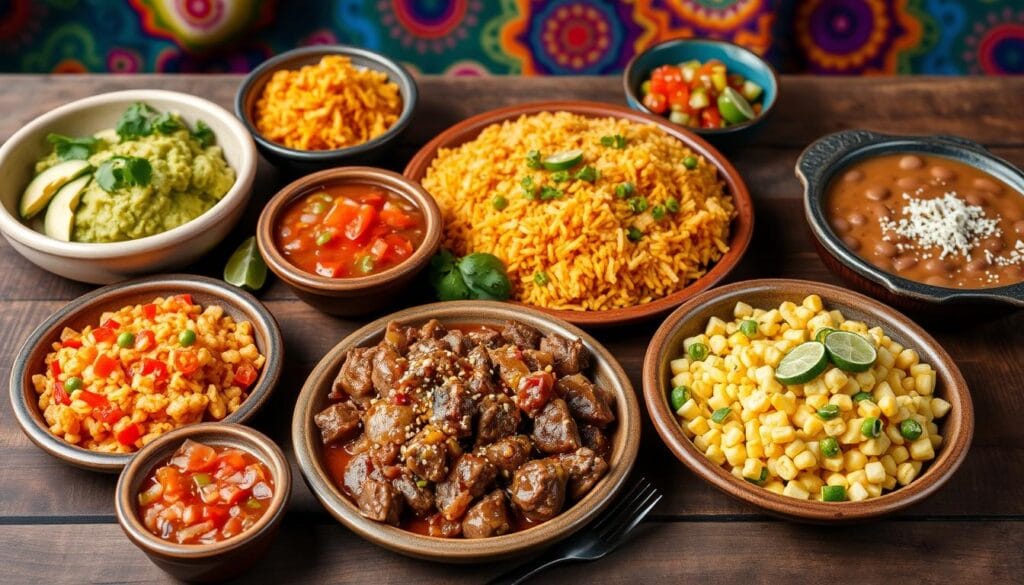
- Mexican Rice: A vibrant, flavorful rice that adds color and texture to your plate
- Refried Beans: Creamy and packed with traditional Mexican flavor
- Fresh Guacamole: Adds a cool, creamy contrast to spicy beef fajitas
- Pico de Gallo: A fresh salsa that brings brightness to the meal
“The right side dish can turn a simple meal into a memorable feast.” – Culinary Traditions
Choosing the right sides can really improve your meal. Tex-Mex dishes like beef fajitas are even better with the right sides.
Pro tip: Make your side dishes before grilling the beef. This way, everything is hot and ready at the same time. It keeps your fajitas warm and makes the meal flow smoothly.
Common Mistakes to Avoid When Making Fajitas
Making delicious beef fajitas needs skill and focus. Even skilled cooks can make mistakes that ruin the dish. Knowing these common errors will help you make amazing fajitas every time.
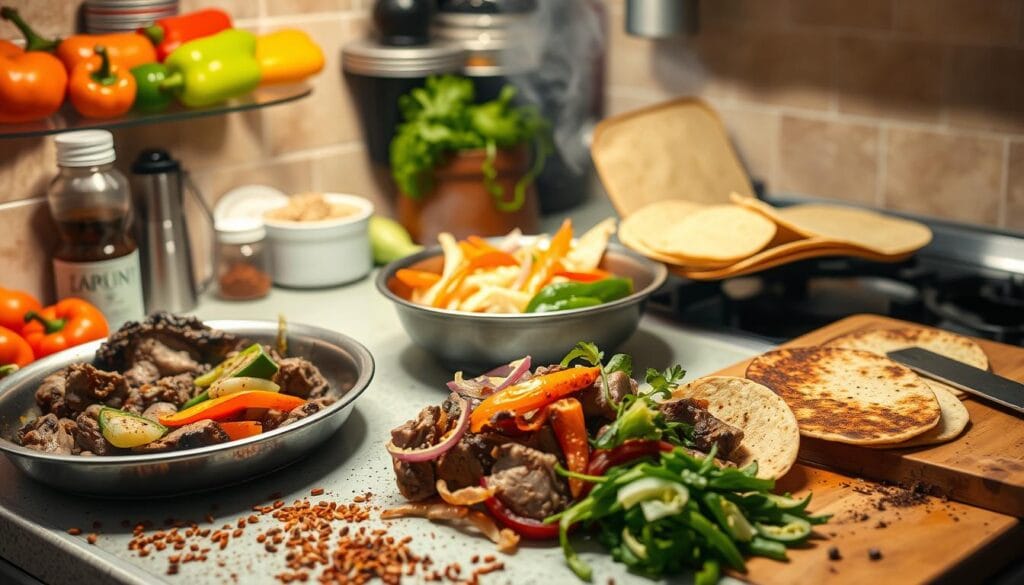
Beef fajitas are more than just grilling meat. You need to be precise in several important steps.
Temperature Control Challenges
Grilled meat needs careful heat control. A rookie mistake can make your steak tough. Here are some common temperature problems:
- Overcrowding the grill, which reduces heat circulation
- Using inconsistent heat zones
- Failing to preheat cooking surfaces
Seasoning and Marinade Missteps
Fajita seasoning is key. Don’t make these common mistakes:
- Over-salting the meat
- Not allowing enough marination time
- Using stale or low-quality spices
Serving and Presentation Errors
The final step of making beef fajitas is just as important. How you present it matters a lot!
| Mistake | Solution |
|---|---|
| Serving cold tortillas | Warm tortillas briefly before serving |
| Overcooking vegetables | Keep vegetables crisp and colorful |
| Improper meat slicing | Cut against the grain for tenderness |
“Perfect fajitas are a balance of technique, timing, and taste.” – Chef Rodriguez
Avoiding these mistakes will make your beef fajitas amazing. Remember, practice makes perfect!
Tips for Hosting a Memorable Fajita Night
Planning a fajita night can turn a simple meal into a fun Mexican cuisine event. Make your Tex-Mex party the highlight of the neighborhood with some planning and creative ideas.
Create an interactive fajita bar where guests can make their own beef fajitas. Offer a variety of fresh ingredients and toppings so everyone can make their ideal meal.
- Set up separate stations for proteins, vegetables, and toppings
- Offer multiple tortilla options (corn and flour)
- Include vegetarian protein alternatives
- Prepare condiments in small, easily accessible containers
Think about dietary needs when planning your Tex-Mex feast. Gluten-free guests will like corn tortillas, and vegetarians might enjoy grilled portobello mushrooms with traditional beef fajitas.
*”The secret to a great fajita night is variety and interaction!”*
Drinks can enhance your Mexican cuisine experience. Serve classic margaritas, Mexican beer, and non-alcoholic choices like horchata or agua fresca.
| Beverage Category | Recommended Drinks |
|---|---|
| Alcoholic | Margaritas, Coronas, Modelo |
| Non-Alcoholic | Horchata, Agua Fresca, Mexican Coca-Cola |
Entertainment can make your fajita night unforgettable. Play Latin music, set up lawn games, or have a simple cooking demo to keep guests engaged.
Follow these tips, and your beef fajitas party will be a memorable celebration of Mexican cuisine and Tex-Mex hospitality.
Storage and Leftover Management for Beef Fajitas
Enjoying steak fajitas is a treat. But knowing how to store leftovers can make your meal last longer. It also helps avoid wasting food. You can turn your leftover beef fajitas into new, tasty dishes.
Proper Storage Methods
Keeping your beef fajitas fresh is key. Here’s how to do it right:
- Separate meat, vegetables, and tortillas before refrigerating
- Store components in airtight containers
- Refrigerate within two hours of cooking
- Consume refrigerated fajita ingredients within 3-4 days
Reheating Techniques
Make your leftover beef fajitas taste like new:
- Use a skillet for meat to maintain its juiciness
- Warm tortillas on a griddle or microwave
- Reheat vegetables quickly to prevent overcooking
- Add a splash of broth to keep meat tender
Creative Leftover Ideas
Turn your steak fajitas into new dishes. This keeps your Mexican cuisine fresh:
- Fajita Quesadillas: Layer leftover meat and vegetables between tortillas
- Beef Fajita Salad: Slice cold meat over mixed greens
- Fajita Nachos: Top tortilla chips with reheated ingredients
- Breakfast Fajita Scramble: Mix with eggs for a morning twist
“Leftovers are not just food saved, but opportunities for culinary creativity!” – Home Cooking Enthuasiast
Follow these tips to keep your beef fajitas tasty and safe. You’ll also discover new ways to enjoy your Mexican cuisine favorites.
Conclusion
Learning to make beef fajitas is more than just a recipe. It’s diving into the heart of Mexican cuisine and Tex-Mex traditions. You’ve now got the skills to whip up dishes that rival those from your favorite restaurants.
Beef fajitas are a flavorful journey that connects you to deep cultural roots. Choosing the right skirt steak and mastering grilling are key. These steps turn simple ingredients into a meal that wows everyone.
With your new skills, you can get creative and make unforgettable meals. Whether it’s for a big gathering or a cozy dinner, beef fajitas bring together amazing flavors and cultural heritage. They’re sure to take your cooking to the next level.
Start this exciting culinary journey with confidence. Your adventures with beef fajitas are just starting. They promise to bring delicious meals and special moments to your dinner table.

